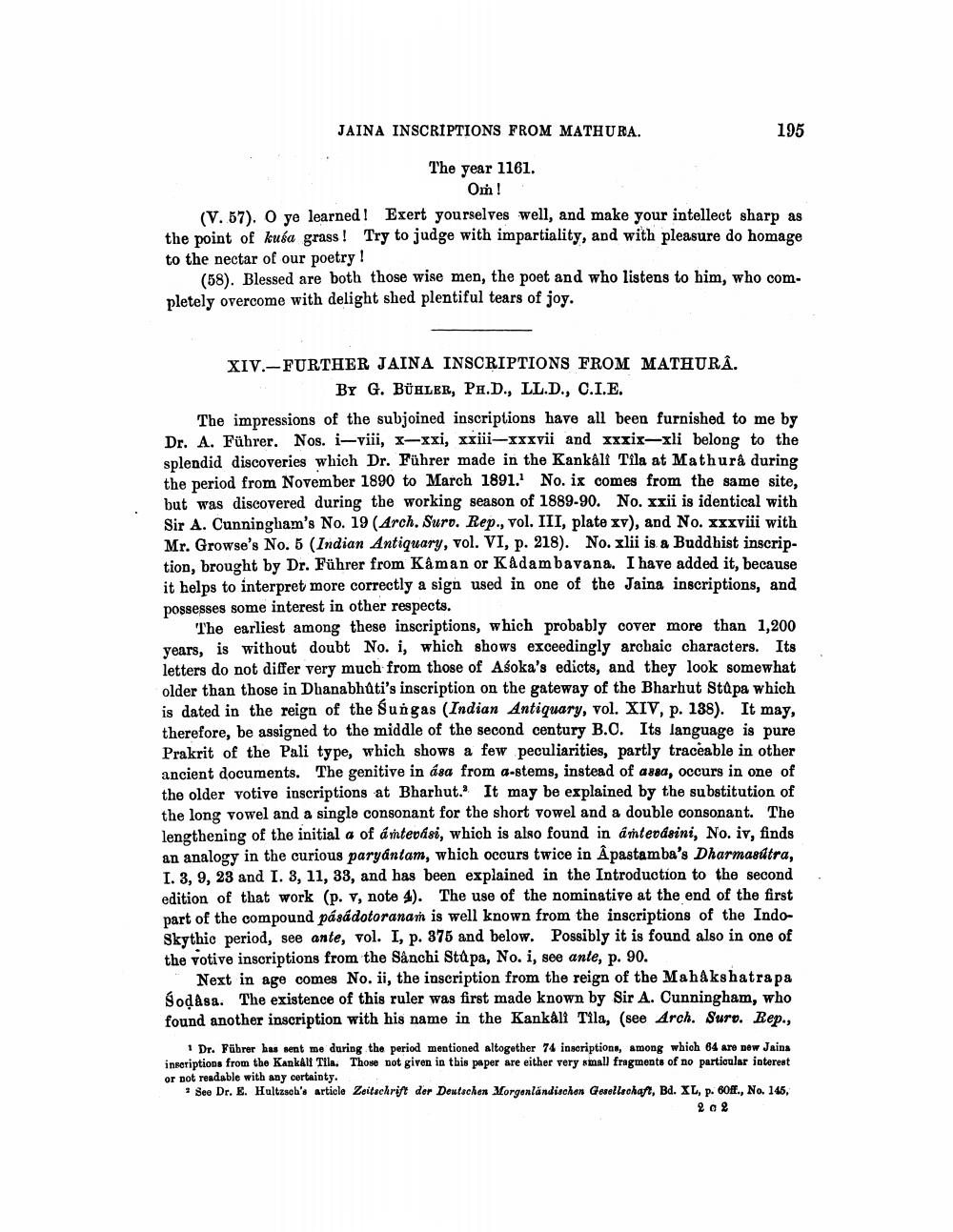________________
JAINA INSCRIPTIONS FROM MATHURA.
195
The year 1161.
Om! (V. 57). O ye learned ! Exert yourselves well, and make your intellect sharp as the point of kuća grass! Try to judge with impartiality, and with pleasure do homage to the nectar of our poetry!
(58). Blessed are both those wise men, the poet and who listens to him, who completely overcome with delight shed plentiful tears of joy.
XIV.-FURTHER JAINA INSCRIPTIONS FROM MATHURÂ.
BY G. BÜHLER, PH.D., LL.D., C.I.E. The impressions of the subjoined inscriptions have all been furnished to me by Dr. A. Führer. Nos. i-viii, x-xxi, xxii-xxxvii and xxxix-xli belong to the splendid discoveries which Dr. Führer made in the Kankali Tila at Mathura during the period from November 1890 to March 1891. No. ix comes from the same site, but was discovered during the working season of 1889-90. No. xxii is identical with Sir A. Cunningham's No. 19 (Arch. Suro. Rep., vol. III, plate xv), and No. xxxviii with Mr. Growse's No. 5 (Indian Antiquary, vol. VI, p. 218). No. xlii is a Buddhist inscription, brought by Dr. Führer from Kaman or Kadambavana. I have added it, because it helps to interpret more correctly a sign used in one of the Jaina inscriptions, and possesses some interest in other respects.
The earliest among these inscriptions, which probably cover more than 1,200 years, is without doubt No. i, which shows exceedingly archaic characters. Its letters do not differ very much from those of Asoka's edicts, and they look somewhat older than those in Dhanabhäti's inscription on the gateway of the Bharhut Stapa which is dated in the reign of the Sungas (Indian Antiquary, vol. XIV, p. 138). It may, therefore, be assigned to the middle of the second century B.O. Its language is pure Prakrit of the Pali type, which shows a few peculiarities, partly traceable in other ancient documents. The genitive in asa from a-stems, instead of assa, occurs in one of the older votive inscriptions at Bharhut. It may be explained by the substitution of the long vowel and a single consonant for the short vowel and a double consonant. The lengthening of the initial a of amtevasi, which is also found in antevdsini, No. iv, finds an analogy in the curious paryantam, which occurs twice in Âpastamba's Dharmasútra, I. 3, 9, 23 and I. 3, 11, 33, and has been explained in the Introduction to the second edition of that work (p. v, note 4). The use of the nominative at the end of the first part of the compound pásádotoranam is well known from the inscriptions of the IndoSkythio period, see ante, vol. I, p. 375 and below. Possibly it is found also in one of the votive inscriptions from the Sånchi Stupa, No. i, see ante, p. 90.
Next in age comes No. ii, the inscription from the reign of the MahAkshatrapa Sodasa. The existence of this ruler was first made known by Sir A. Cunningham, who found another inscription with his name in the Kankali Tila, (see Arch. Suro. Rep.,
1 Dr. Fübrer has sent me during the period mentioned altogether 74 inscriptions, among which 64 are new Jaina insoriptions from the Kankall Tila. Those not given in this paper are either very small fragments of no particular interest or not readable with any certainty.
See Dr. E. Hultzsch's article Zeitschrift der Deutschen Morgenländischen Gesellschaft, Bd. XL, p. 60f., No. 145,




